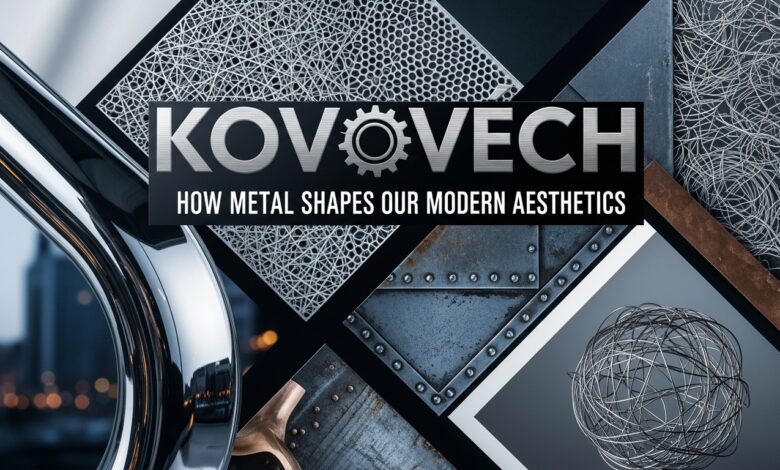Kovových: How Metal Shapes Our Modern Aesthetics

Metal has long been an essential part of human civilization, shaping our tools, structures, and even our art. Enter Kovových—a term that embodies the essence of metal and its profound impact on aesthetics. From towering skyscrapers to intricate jewelry, metals create a harmony between form and function that captivates the eye. In this exploration of Kovových, we will delve into how different types of metal have influenced design throughout history and how they continue to do so in contemporary society. Whether you’re an artist seeking inspiration or simply curious about the world around you, understanding Kovových opens up a universe where creativity meets innovation.
The History of Metal in Art and Design
Metal has a rich history that intertwines with human creativity. From ancient civilizations shaping gold into intricate jewelry to artisans crafting bronze sculptures, metal has always been a medium of choice.
In the Renaissance, artists like Donatello pushed boundaries using metals for both functional and decorative purposes. Their works showcased not just skill but innovation in casting techniques.
As industrialization surged, metal evolved further. Steel became synonymous with strength and progress during the 19th century. It transformed architecture and design forever.
Modern artists continue to explore metals with fresh perspectives. Contemporary sculptors blend steel and aluminum to create stunning installations that challenge our perceptions of space and form.
Throughout time, metal has transcended mere utility. It embodies culture, history, and artistic expression in every shape it takes.
The Influence of Metal on Modern Architecture
Metal has become a cornerstone in modern architecture, redefining structural possibilities. Buildings now soar higher and stretch wider thanks to its strength-to-weight ratio. Steel and aluminum allow for expansive spaces without compromising stability.
The aesthetic appeal of metal also plays a significant role. Designers incorporate it not just as a framework but as an integral part of the visual identity. Sleek facades and intricate patterns engage viewers at every angle.
Sustainability is another aspect where metal shines. Recyclable materials contribute to eco-friendly practices, aligning with contemporary values around green living.
Architects often juxtapose metal with natural elements like glass or wood, creating striking contrasts that evoke sophistication and warmth. This blending fosters unique environments that challenge conventional perceptions of space.
As cities evolve, the use of metal continues to inspire innovation while pushing architectural boundaries further than ever before.
Metal in Fashion: From Functional to Decorative
Metal has transitioned from a utilitarian material to a staple in the fashion world. Initially, metal served practical purposes—think buttons, zippers, and hardware. Over time, it evolved into an essential decorative element.
Jewelry is perhaps the most obvious example of this transformation. Designers now use metals like gold, silver, and brass to create stunning pieces that enhance any outfit. These materials add elegance and sophistication while showcasing craftsmanship.
Beyond jewelry, metals find their way into clothing through embellishments and accents. Studded jackets or metallic fabrics catch the eye and make bold statements on runways worldwide.
Fashion designers often experiment with different textures and finishes as well. Shiny chrome contrasts beautifully with matte surfaces, offering depth to designs that appeal to modern sensibilities.
This blend of function and artistry demonstrates how metal elevates fashion beyond mere utility into realms of creativity and expression.
The Role of Metal in Technology and Industrial Design
Metal plays a pivotal role in technology and industrial design, serving as the backbone of countless innovations. Its strength and durability make it an ideal choice for structural components in machinery and equipment.
In electronics, metals like copper and aluminum are vital for conducting electricity. They empower everything from small gadgets to large-scale operations. The versatility of metal allows designers to create sleek, functional products that withstand wear and tear.
Additionally, metals can be molded into intricate shapes, enhancing both performance and aesthetics. This adaptability leads to unique applications across industries—from automotive parts to consumer electronics.
Sustainability also factors into the conversation. Many manufacturers now prioritize recyclable metals, reducing environmental impact while maintaining high-quality standards. As technology evolves, so too will the ways we incorporate kovových elements into our designs.
This ongoing innovation keeps pushing boundaries in industrial design forward at an impressive pace.
Exploring Different Types of Metal and Their Uses
Metal comes in numerous forms, each with unique properties and uses. Steel, for instance, is a staple in construction. Its strength makes it ideal for beams and frameworks.
Aluminum stands out for its lightweight nature. This quality has led to its widespread use in transportation, from aircraft to bicycles.
Copper is another fascinating metal. Known for its excellent conductivity, it plays a vital role in electrical wiring and plumbing systems.
Titanium boasts incredible resistance to corrosion. As a result, it’s found frequently in medical implants and aerospace applications.
Brass combines copper and zinc for durability while providing an attractive finish. It’s often used in decorative objects like musical instruments and hardware fittings.
Each type of metal offers distinct advantages that cater to various industries, shaping our everyday lives significantly. Whether structural or ornamental, the versatility of metals continues to inspire innovation across multiple fields.
The Future of Kovových: Innovative Applications and Sustainability
The future of Kovových lies at the intersection of innovation and sustainability. As society becomes more environmentally conscious, metal’s role is evolving dramatically.
New technologies are paving the way for recycling metal with minimal waste. This not only preserves natural resources but also reduces energy consumption in production processes.
In architecture, we see metals like aluminum being used to create lightweight structures that require less material without sacrificing durability. These designs promote energy efficiency and lower carbon footprints.
Fashion designers are also exploring sustainable practices using upcycled metals, transforming discarded items into stunning jewelry or accessories that tell a story.
Moreover, advancements in 3D printing with metallic materials open doors to bespoke creations tailored to individual needs while minimizing excess production.
As industries embrace these changes, Kovových will likely redefine aesthetics while championing a greener planet for future generations.
Conclusion: How Kovových Continues to Shape Our World
Kovových continues to be a vital force in shaping our world. From the intricate designs seen in modern architecture to the sleek aesthetics of fashion, metal plays a crucial role in how we perceive beauty and functionality. Its presence is felt across various fields, including technology and industrial design, pushing boundaries and inspiring innovation.
As we look ahead, the versatility of Kovových promises even more groundbreaking applications. With sustainability becoming increasingly significant, new methods are emerging for recycling and repurposing metal materials. This not only enhances their aesthetic appeal but also contributes positively to environmental efforts.
The future will likely see Kovových evolving into forms that blend artistry with practicality. As designers embrace these changes, they will continue to experiment with metals in exciting ways that resonate with contemporary values and lifestyles.
Metal’s ability to transform spaces and objects ensures it remains at the forefront of artistic expression and technological advancement. The journey of Kovových is far from over; its impact on our lives will only grow as creativity meets innovation head-on.



